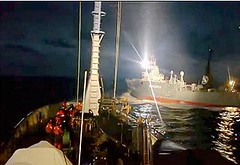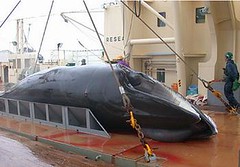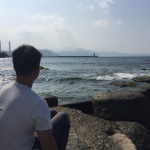 日本捕鯨船的捕鯨活動剛結束,今年的漁獲量不到往年1/3,鯨魚保育團體海洋守護者協會的成員在環繞著南極的南大洋地區,戰勝日本的捕鯨者之後返回澳洲港口城市霍巴特。
日本捕鯨船的捕鯨活動剛結束,今年的漁獲量不到往年1/3,鯨魚保育團體海洋守護者協會的成員在環繞著南極的南大洋地區,戰勝日本的捕鯨者之後返回澳洲港口城市霍巴特。
該會創會主席華生船長9日表示,「任務成功達成,我們過去3個月的阻撓行動開花結果:數百計的鯨魚逃離日本捕鯨船的魔爪,如今悠游海洋中。我們衷心感到欣慰。」日本的捕鯨船隊連續2年迫於壓力放棄了年度大規模捕鯨活動。
行動人士表示,他們成功地「打敗」了日本的捕鯨船隊,迫使他們捕撈到的鯨魚的數量,還不到往年的1/3,「我們就救下了768條鯨魚」。希望經濟上的損失能夠迫使日本捕鯨船隊最終放棄捕鯨。
日本水產廳9日也表示,該國捕鯨船對照原訂計劃從南冰洋返還,共捕獲266隻小鬚鯨和1隻長鬚鯨。針對這一季從2011年12月開始所謂的「科學研究捕鯨活動」,水產廳設定的捕鯨上限為900隻。
 從2011年12月起,海洋守護協會就像往年一樣,開始干擾日本捕鯨船的捕鯨活動。華生說到,該機構的厄文(Steve Irwin)和巴克(Bob Barker)兩艘護鯨船,追蹤日本捕鯨船超過1萬7千哩,讓他們幾乎沒有時間捕鯨,「3艘捕鯨船中有2艘,花在追趕我們的時間反而比捕鯨來的多。」
從2011年12月起,海洋守護協會就像往年一樣,開始干擾日本捕鯨船的捕鯨活動。華生說到,該機構的厄文(Steve Irwin)和巴克(Bob Barker)兩艘護鯨船,追蹤日本捕鯨船超過1萬7千哩,讓他們幾乎沒有時間捕鯨,「3艘捕鯨船中有2艘,花在追趕我們的時間反而比捕鯨來的多。」
華生對護鯨行動未傷及日本船員感到自豪,並解釋該會目地就是從經濟上打沉日本捕鯨業,徹底瓦解其非法捕鯨行動。
這是該會第八次在南冰洋執行護鯨任務。護鯨策略包括出動載有護鯨人員的小型充氣艇,投擲臭屁彈(butyeric acid stink bombs)和使用噴槍噴射船隻,也投擲繩索企圖纏繞、糾結捕鯨船的螺旋槳,使之無法行動。
捕鯨船不甘勢弱回敬水槍掃射小艇上的護鯨人士。不過這些你來我往的爭鬥,都隨著南冰洋的結冰期來臨,日本捕鯨船回航,而終告一段落。
過去七次在南冰洋鯨魚禁捕區的護鯨行動,該會共拯救超過2,781隻鯨魚。南冰洋鯨魚禁捕區為5千萬平方公里,環繞南極大陸的海域,從1994年就由國際捕鯨委員會(IWC)指定為禁止商業捕鯨區域。
 國際捕鯨委員會發布的商業捕鯨暫時禁令,在1986年就生效了。然而在1987年,日本繼續捕鯨,宣稱捕鯨行動依據IWC規章,是基於「科學研究」上的捕鯨行為,所以完全合法。
國際捕鯨委員會發布的商業捕鯨暫時禁令,在1986年就生效了。然而在1987年,日本繼續捕鯨,宣稱捕鯨行動依據IWC規章,是基於「科學研究」上的捕鯨行為,所以完全合法。
2010年,澳洲首度在海牙的國際法庭上控告日本在南冰洋禁區所謂的「科學研究」捕鯨行為為不合法。
過去大約10年來,這個總部設在美國的非營利組織一直跟蹤著日本捕鯨船隊的動向,一直追蹤到南大洋,目的就是要阻止他們的捕鯨活動。華生警告,如果日本捕鯨船在2012年12月企圖再次闖入南冰洋鯨魚禁捕區,他們會出動2架直升機、4艘護鯨船、4架無人架駛飛機,加上120名志工編組成「護鯨正義任務」(Operation Cetacean Justice),再次為鯨魚發聲。
The whale conservation group Sea Shepherd is celebrating victory as Japan ends its whaling season with less than a third of its annual self-assigned quota.
"It has been a successful campaign," Sea Shepherd founding president Captain Paul Watson said Friday. "There are hundreds of whales swimming free in the Southern Ocean Whale Sanctuary that would now be dead if we had not been down there for the last three months. That makes us very happy indeed."
The Japanese Fisheries Agency said Friday that the whaling fleet is homeward bound from the Southern Ocean "on schedule" with 266 minke whales and one fin whale. By comparison, the agency set a quota of 900 whales when the Japanese whalers began their "research" whaling in December 2011.
"The catch was smaller than planned due to factors including weather conditions and sabotage acts by activists," a Fisheries Agency official told Agence France Presse. "There were definitely sabotage campaigns behind the figure."
Three vessels from the U.S.-based nonprofit Sea Shepherd have been interfering with the Japanese whalers to prevent them from killing whales since December.
Watson said that Sea Shepherd ships the Steve Irwin and the Bob Barker were able to chase the Japanese whaling fleet for more than 17,000 miles, giving them little time to kill whales. "Two of the three harpoon vessels spent more time tailing the two Sea Shepherd ships than killing whales," he said.
"Once Captain Peter Hammerstedt and his crew on the Bob Barker closed in on the Nisshin Maru on March 5th, the whaling season was effectively over for the season," said Watson, speaking from the Steve Irwin, which is now in Williamstown, Australia for refueling.Japan's Institute of Cetacean Research, which sponsors the whaling fleet, described the March 5 encounter with the Bob Barker this way. "On March 5 at around 1930 JST Antarctic whale research (JARPAII) vessels encountered a Sea Shepherd ship the Bob Barker when they were moving after having ended another day of research activities."
"As a measure to maintain security at sea the slower research base vessel the Nisshin Maru immediately started avoidance steerage while research vessels the Yushin Maru No. 2 and the Yushin Maru No. 3 repeatedly broadcasted a warning message and towed from their stern a rope with keep-your-distance-warning buoys as a containment measure to make the Bob Barker desist from approaching the Nisshin Maru."
"Around 2005 JST the Bob Barker started firing more than 40 flare signals and delivering a high-power laser beam toward the YS2 and YS3. The laser delivering lasted for about 50 minutes. There were neither injuries to the Japanese crews or damage to both vessels from the Bob Barker's attack," the Japanese agency said.
The Sea Shepherd describes the March 5 encounter differently. "Darkness was rapidly closing in and snow was beginning to fall, when in a desperate move to throw the Bob Barker off the back of the Nisshin Maru, the two harpoon vessels began passing dangerously across the bow of the Bob Barker dragging 300 meter long, thick cables to foul the prop of the Bob Barker."
"The harpoon ships trained their spotlights on the bridge of the Bob Barker, in an effort to blind the crew but backed off when the Bob Barker crew retaliated with lasers. Flares were fired and angry radio messages exchanged in Japanese and English," Sea Shepherd said on its website. "The Yushin harpoon vessels illegally turned off their running lights during the incidents contributing to the danger of their reckless maneuvers."
Captain Hammarstedt, 27, a veteran of numerous Sea Shepherd campaigns, avoided the Japanese fouling lines.
"Captain Hammarstedt and his crew are bravely taking on the entire whaling fleet and keeping them on the run," Watson said. "There is no question that this is an exceedingly dangerous conflict but there is also no doubt that it is being highly effective."
Watson takes pride in never having injured any Japanese crew member and has said that the Sea Shepherd's objective is "to sink the Japanese whaling fleet economically and bankrupt their illegal activities."
This is Sea Shepherd's eighth straight season of anti-whaling activities in the Southern Ocean.
Tactics include sending activists in small inflatable boats from the larger Sea Shepherd ships to throw butyeric acid stink bombs and aim paint guns at the whaling vessels. They have used ropes to try to entangle the whalers' propellers.
The whalers have retaliated by shooting water cannon at the activists. But all that is over for the season as the Southern Ocean begins to freeze over and the whaling fleet heads back to Japan.
Watson said the Japanese government security vessel Shonan Maru #2 has been spotted by fishing vessels at 30 degrees South due east of Brisbane, Australia, indicating that the vessel is well on its way to Japan.
"The kill figures will not be released by Japan until April, but in my opinion they will not get over 50 percent for certain and my prediction is it will not be above 30 percent. Not as good as last season, but much better than all the previous years," said Watson.
In the 2010-2011 season, the Japanese whalers went home early after killing just 172 whales out of their self-assigned quota of 900 because of Sea Shepherd interference.
In December 2012, if the Japanese whaling fleet returns to the Southern Ocean Whale Sanctuary, the Sea Shepherd Conservation Society will launch Operation Cetacean Justice with four ships, two helicopters, four UAV (drones), and 120 volunteers, Watson said Friday.
"If the Japanese whalers return, Sea Shepherd will return," he said. "We are committed to the defense of the Southern Ocean Whale Sanctuary. No matter how long it takes, no matter how risky or expensive. The word 'sanctuary' actually means something to us and that something is worth fighting for."
Watson says that during the past seven campaigns against Japanese whalers in the Southern Ocean Whale Sanctuary, Sea Shepherd actions have saved the lives of over 2,781 whales.
The Southern Ocean Whale Sanctuary is an area of 50 million square kilometers surrounding the continent of Antarctica where the International Whaling Commission, IWC, has banned commercial whaling since 1994.
In addition, the IWC has placed a moratorium on all commercial whaling that took effect in 1986.
Since 1987, Japan has continued to hunt whales, calling its whaling "perfectly legal" because it is done under a provision in the IWC charter that permits whaling for the purposes of scientific research.
In 2010, Australia initiated legal action in the International Court of Justice in The Hague against Japan's so-called "scientific" whaling in the Southern Ocean Sanctuary.
The Japanese government now issues itself "scientific permits" to kill up to 935 minke whales and 50 endangered fin whales in the Southern Ocean Whale Sanctuary every year and up to 220 minke whales, 100 sei whales and 10 sperm whales in the North Pacific.






